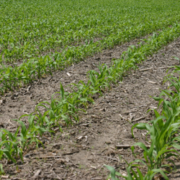Early Season Weed Control In Corn Is Vital
This article was written by Mark Rosenberg, former SDSU Extension Agronomy – Weeds Field Specialist.
Early season weed control is vital to both future yields and profitability, because early weed flushes compete intensely with corn for both nitrogen (N) and water. Dense weeds can also shade soils and make them cooler so that corn grows more slowly.”
So, when does early season weed control need to be done before it’s too late to stop yield loss? According to weed research, conducted across the Midwest including South Dakota, given that you start with a clean field, the most competitive weeds in corn will be about 3-4 in. high when corn reaches the V3-V4 growth stage. If you don’t remove those 3-4-in. weeds promptly, you’ll be losing about 3 bu./acre for every day you delay. Minnesota studies over three years show corn lost between 12-13 bu./acre within the first week and 27-29 bu./acre within the second week if weeds were allowed to remain in the field after they reached 4 in. in height.
A big yield loss early in the season could mean the difference between making or losing money, Depending on soil moisture and fertility levels, waiting to control weeds until corn reaches the V3-V4 growth stage can push you over the economic threshold for profitability. At about 4-6-in.-tall corn and weeds, is when producers typically pass the breakeven mark and start losing money to lost yields from weed pressure after factoring in the cost of the herbicide application.”
Especially in corn, profitable weed control is all about timing to ensure successful weed control. University Weed Scientists and Extension Specialists recommend the following five tips to help guide farmers towards more profitable corn weed management:
Start clean.
A clean field at planting is essential for starting the corn crop off right. This can be achieved by using tillage, herbicides or some combination of the two.
SDSU Extension Weed Science Project recommends using a burn-down with residual chemistry that is targeted to the specific weed spectrum for each field. Use of a soil-residual herbicide will help to both start the crop off clean and to manage the field for any potential glyphosate-resistant weeds, such as waterhemp and giant ragweed, or to reduce the potential development of these and other herbicide-resistant weed biotypes.
Minimize risk.
A total post-emergence program is the most risky weed-control system, because the timing of a post-emergence herbicide application is almost completely up to Mother Nature, and no one can control the weather. Instead, try using an integrated program with some soil-residual products. Also, farmers could consider a split application of an early pre-plant treatment followed either by a pre-emergence or a post-emergence treatment to provide more consistent weed control than a single, early pre-plant application.
A pre-emergence herbicide application will help keep late-emerging weeds small and uniform enough in height to boost odds for success when following up with a post-emergence treatment. Using a pre-emergence herbicide buys you more time to apply your post-emergence herbicide for optimal weed control,” he says.
In addition, a pre-emergence herbicide can be an especially good investment with irrigation, which ensures moisture is available at the right time to activate the chemistry. When dealing with dry land cornfields using a residual pre-emergence program will still be beneficial in reducing potential problems with glyphosate-resistant weeds, even if a lack of rainfall delays activation past the ideal time for starting corn out in clean fields.
Timing is everything.
The main management focus should be on controlling those early weeds. Research conducted in Minnesota, and Wisconsin, shows that at about the V3-V4 stage, if weeds aren’t removed, fields will suffer an average 3 bu./acre/day yield loss up until the end of June. In fact, farmers should plan to have all their weed control completed by the Fourth of July.
Timing is important for both post- and pre-emergent applications. For pre-emergent herbicide applications, try to time them closer to when you plant, especially if you have a weed spectrum in the field that can emerge later in the season, such as waterhemp.
Weeds that re-infest after an initial herbicide application can also be very competitive. The SDSU recommends being vigilant to control these later weed flushes, if necessary, while they are also still small.
Avoid reduced rates.
Many farmers run reduced herbicide rates of soil-residual herbicides to save costs. However, with reduced rates, you may be setting the product up to fail earlier, depending on weather conditions and weed pressure. Using a full, or a nearly full rate based on soil type often provides an extended period of weed control that you don’t always have with reduced rates.
Especially in the post-emergence arena, good early season weed control has a lot to do with proper timing and not skimping on rates. Also, when you do post-emergence weed control, make sure you don’t go too fast and check to make sure you’re getting good spray coverage on weeds.”
Scout and reassess.
After each weed-control practice, producers need to scout fields and evaluate how well their treatment worked and whether or not a remedial treatment might be needed.




